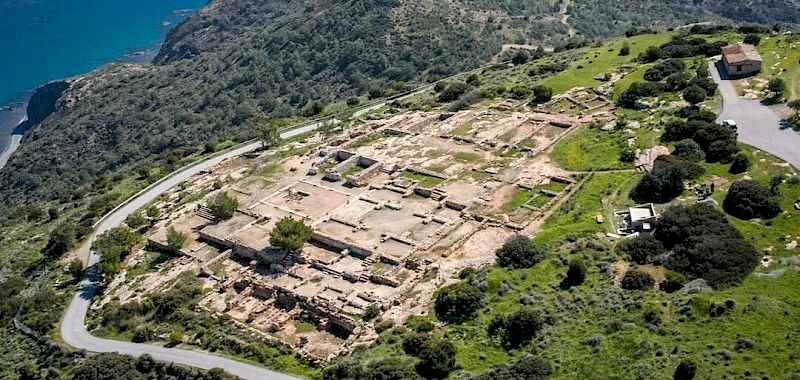The Ancient City of Vouni
Not only is it one of the oldest landmarks in Cyprus, but it also offers a stunning panoramic view of the island’s northwest coast.
Vouni Palace is an ancient monument from the Persian and Greek periods, located on the western coast of Cyprus, by the sea. Today, the ruins of Vouni Palace offer insight into the political struggles and cultural exchanges that shaped Cyprus during the Classical period. The site also boasts breathtaking views of the sea and mountains, as it sits high on a standalone hill.
- History of Vouni Palace
- Vouni Ruins Today
- What the Palace Contains
- How to Get to Vouni
- Frequently Asked Questions

History of Vouni Palace
Vouni Palace was built around 470 BC during the Persian rule when Cyprus was part of the Achaemenid Empire. Its strategic location overlooking the coast played a critical role in the power struggles between Greek and Persian factions on the island.
The palace was destroyed by fire around 380 BC, possibly during conflicts between the Greek city-states of Cyprus and Persian-backed rulers. Around this time, the nearby city of Marion was also razed, marking the decline of Persian influence in the region.
Excavations have uncovered Persian and Greek pottery, showing evidence of cultural exchange between these civilizations. Interestingly, a Swedish archaeological expedition dismissed the theory that Vouni was the ancient city of Aipeia, the predecessor of Soli, as no findings older than the 5th century BC were discovered at the site.
Vouni Ruins Today
Today, the site has been transformed into a museum with a ticket booth. Thanks to its unique location and the spectacular views from the hilltop, Vouni Palace is popular not only with history enthusiasts but also with visitors who come to admire the scenery. It’s no surprise that we’ve included it in our list of the best viewpoints in Northern Cyprus.
What the Palace Contains
Excavations conducted in the early 20th century revealed the palace’s remains, including inner courtyards, living quarters, and storage rooms. All of these areas are open for visitors to explore.
One notable feature is the Temple of Athena, located at the highest point of the hill. Archaeologists found a bronze bowl inscribed with Athena’s name, along with bronze weapons and numerous sculptures likely representing the goddess. This led them to conclude that it was indeed a temple dedicated to Athena.
How to Get to Vouni
-
By Public Transport:
From Nicosia or Kyrenia, first travel to Güzelyurt. From there, take a bus to Lefke. You’ll need to get off before the Lefke turn and either take a taxi or hitch a ride towards Yeşilyurt village. Once you reach the road to Vouni, it's just a short walk uphill. Even children as young as 5 can manage the climb. - How to get from Nicosia to Güzelyurt?
- How to get from Girne to Güzelyurt?
-
By Car:
You can find the location and GPS coordinates below: 35.15859440724254, 32.77330272152262. After turning off the Lefke-Yeşilyurt road, you’ll see a gate with the operating hours listed. If you arrive within 30 minutes of closing time, the gates may already be shut.
Frequently Asked Questions
-
What are Vouni’s opening hours?
- Winter (November-May): 8:00 AM to 3:30 PM
- Summer (June-October): 8:00 AM to 6:00 PM
-
How much does the ticket cost?
The 2024 ticket price is 100 lira per person. Children under 8 and students receive a 50% discount. Tickets are sold at the top of the site, not at the entrance gate. -
Is there parking at Vouni Palace?
Yes, there is a small parking lot that holds up to 10 cars, but since the site is still relatively undiscovered by tourists, parking is usually available. The parking lot is located right next to the ticket booth.
Follow us on Instagram and Telegram to learn more about Northern Cyprus' most fascinating attractions!

